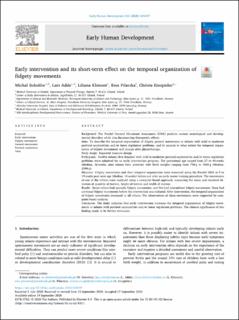| dc.description.abstract | BACKGROUND: The Prechtl General Movement Assessment (GMA) predicts various neurological and developmental disorders while also documenting therapeutic effects. AIMS: To describe the temporal organization of fidgety general movements in infants with mild to moderate postural asymmetries and/or tonus regulation problems, and to analyze to what extent the temporal organization of fidgety movements will change after physiotherapy. STUDY DESIGN: Repeated measure design. PARTICIPANTS: Twelve infants (five females) with mild to moderate postural asymmetries and/or tonus regulation problems were admitted for an early intervention program. The gestational age ranged from 27 to 40 weeks (Median, 36 weeks; nine infants born preterm) with birth weights ranging from 740 g to 3500 g (Median, 2590 g). MEASURES: Fidgety movements and their temporal organization were measured using the Prechtl GMA at 9 to 19 weeks post term age (Median, 14 weeks) before and after an early motor training procedure. The movements of one of the infants were analysed using a computer-based approach, measuring the mean and standard deviation of quantity of motion, height of motion and width of motion. RESULTS: Seven infants had sporadic fidgety movements, and five had intermittent fidgety movements. None had continual fidgety movements before the intervention was initiated. After intervention, the temporal organization of fidgety movements increased in all infants. The observations of these movements were supported by computer-based analysis. CONCLUSION: The study indicates that early intervention increases the temporal organization of fidgety movements in infants with postural asymmetries and/or tonus regulation problems. The clinical significance of this finding needs to be further evaluated. | en_US |

